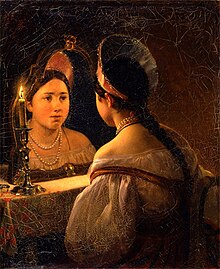Catoptromancy
The Katoptromantie ( Greek katoptron , mirror and manteia , divination) is a form of divination , looks in which, in a specular surface. The aim of catoptromance is the prediction of the future ( precognition ), the knowledge of hidden facts from the past ( retrocognition ) or the exploration of hidden objects. Catoptromance is a special type of hydromance , in which phenomena in and above the surface of water are observed.
Concept formation
Fortune telling from mirrors was first referred to in the 16th century by Gerolamo Cardano as catoptromance. In Meyers Konversations-Lexikon of 1907 the term catoptromance is expanded and includes reflections on the surface of water or crystals, in polished basins or beakers and in mirrors made of metal , glass or obsidian . If the term catoptromance is used in literature today, it is usually understood as catoptromance in the narrower sense, i.e. divination using mirrors. If the reflection takes place on other reflective surfaces, one also speaks of crystal romance . In English-speaking countries, the term catoptromancy is also used for any reflective surfaces.
history
The mirror prophecy was already known in antiquity and was probably also practiced in temples. Early Greek and Roman oracle practices may have been associated with earth deities such as Demeter and Ceres . With the Etruscans in particular , the mirror has been shown to be an instrument for predicting the future. Fortune telling from mirrors is specifically mentioned by Pausanias in the 2nd century AD . The oracle mirror also revealed things that were not really present before him. However, catoptromance does not seem to have been an independent oracle discipline . The mantic function of mirror and mirroring occurred in most cases only in the accompaniment of hydromantic or leconomant . Only from the oracle questioning of the Roman emperor Didius Julianus is it recorded that only a mirror was used. Since late antiquity , wandering fortune tellers who predicted the future from all possible reflective surfaces have been known as specularii from lat . speculum , mirror.
In the Middle Ages and the early modern period the Spiegelmantik was widespread. The eminent English theologian John of Salisbury (1115–1180) complained about fortune-telling from polished and reflective kettles, beakers, glasses and mirrors. The decisive factor for the prophecy was whether the image of the reflected object looked clear and distinct or distorted and out of focus. So you dived z. B. a mirror under water and let a sick person look into it in order to obtain a judgment about the outcome of the illness. If the patient's picture was clearly visible, a speedy recovery could be expected. If the reflection in the mirror was distorted, this was considered a bad omen. In the Middle Ages there were also special mirror showers who wanted to track down hidden treasures with so-called mountain or earth mirrors. Often times, children were made to look in the mirror during the mirror prophecy. Allegedly, the French Queen Catherine de Medici is said to have asked her mirror about the future rulers of France.
See also
literature
- Miranda Anderson: The Book of the Mirror: An Interdisciplinary Collection Exploring the Cultural History of the Mirror. Scholars Press, Cambridge 2007, ISBN 9781847181930 .
- Lilian Balensiefen : The meaning of the mirror image as an iconographic motif in ancient art. Verlag E. Wasmuth, Tübingen 1990, ISBN 3803019095 .
- Adam Max Cohen: Shakespeare and Technology: Dramatizing Early Modern Technological Revolutions. Palgrave Macmillan, New York / Basingstoke 2006, ISBN 9781137120045 .
- Gustav W. Gessmann: Catechism of the divination arts. Verlag der Hofbuchhandlung, Berlin 1892.
- Nancy Thomson de Grummond : Etruscan Myth, Sacred History and Legend. University of Pennsylvania, Philadelphia 2006, ISBN 9781931707862 .
- Dieter Harmening: Superstitio. Traditional and theoretical studies of ecclesiastical and theological superstition literature of the Middle Ages, Volume 1. Erich Schmidt Verlag, Berlin 1979, ISBN 3503012915 .
- Christa Agnes Tuczay : Cultural History of Medieval Fortune Telling. De Gruyter, Berlin 2012, ISBN 3110240416 .
Individual evidence
- ↑ http://www.zeno.org/Meyers-1905/A/Katoptromant%C4%ABe (September 15, 2018)
- ↑ http://www.zeno.org/Pierer-1857/A/Katoptromantie (September 15, 2018)
- ↑ Dieter Harmening: Superstitio. Traditional and theoretical studies of church-theological superstition literature of the Middle Ages, Volume 1, p. 104.
- ↑ http://www.zeno.org/Meyers-1905/A/Katoptromant%C4%ABe (September 15, 2018)
- ↑ Lilian Balensiefen: The meaning of the mirror image as an iconographic motif in ancient art. P. 167.
- ↑ Christa Agnes Tuczay: Cultural history of medieval fortune-telling. P. 68.
- ^ Miranda Anderson: The Book of the Mirror: An Interdisciplinary Collection Exploring the Cultural History of the Mirror. P. 32.
- ↑ http://www.zeno.org/Meyers-1905/A/Katoptromant%C4%ABe (September 15, 2018)
- ^ Miranda Anderson: The Book of the Mirror: An Interdisciplinary Collection Exploring the Cultural History of the Mirror. P. 40.
- ^ Nancy Thomson de Grummond: Etruscan Myth, Sacred History and Legend. P. 30.
- ↑ Dieter Harmening: Superstitio. Traditional and theoretical studies of church-theological superstition literature of the Middle Ages, Volume 1, p. 104.
- ↑ Lilian Balensiefen: The meaning of the mirror image as an iconographic motif in ancient art. P. 167.
- ↑ Lilian Balensiefen: The meaning of the mirror image as an iconographic motif in ancient art. P. 182
- ^ Adam Max Cohen: Shakespeare and Technology: Dramatizing Early Modern Technological Revolutions. P. 164.
- ^ Adam Max Cohen: Shakespeare and Technology: Dramatizing Early Modern Technological Revolutions. P. 164.
- ^ Gustav W. Gessmann: Catechism of the divination arts. P. 180
- ↑ http://www.zeno.org/Meyers-1905/A/Katoptromant%C4%ABe (September 15, 2018)
- ^ Gustav W. Gessmann: Catechism of the divination arts. P. 181


